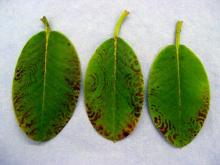Cause A potexvirus, rhododendron necrotic ringspot virus, has been associated with symptoms of this disease but has not been experimentally proved the cause. Transmission likely is by vegetative propagation, but other methods or vectors are unknown. Insect such as aphids are known to transmit other potex viruses. Pollen or seed may be a means of transmission because many seedlings have been reported with symptoms. Both evergreen Rhododendrons and Kalmia latifolia can be affected. The problem is widespread in the Pacific Northwest.
Symptoms Necrotic rings become apparent in 2-year-old leaves. Current-season growth and flowers are unaffected. Concentric rings become more numerous during the growing season. Leaves generally turn red or yellow and fall prematurely from the plant. Loss of plant vigor also has been reported. Amount of sunlight may be a factor in symptom development.
Cultural control
- Remove and destroy symptomatic plants. Do not propagate from plants showing symptoms.
Reference Coyier, D.L., Stace Smith, R., Allen, T.C., and Leung, E. 1977. Viruslike particles associated with a rhododendron necrotic ringspot disease. Phytopathology. 67. 1090-1095.



